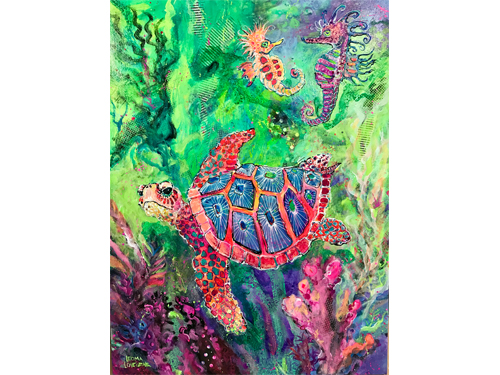 I am thrilled to announce that I am the cover artist on this month’s edition of Jupiter Inlet. The magazine features a story on seahorses and they used one of my paintings for their cover art. In the article (“Seahorses are here”), Debbie Fritz Quincy (who’s the Director of the Hobe Sound Nature Center) provides some fascinating facts about the “regal animals” who “wear a crown of spines on their horse-like heads.”
I am thrilled to announce that I am the cover artist on this month’s edition of Jupiter Inlet. The magazine features a story on seahorses and they used one of my paintings for their cover art. In the article (“Seahorses are here”), Debbie Fritz Quincy (who’s the Director of the Hobe Sound Nature Center) provides some fascinating facts about the “regal animals” who “wear a crown of spines on their horse-like heads.”
If you’re like me and Ms. Quincy, you’re probably intrigued by seahorses too. They’re actually one of my favorite motifs to paint. Lots of the folks who attend Vino’s Picasso painting parties feel the same way. They love recreating the seahorses they find here at Lovegrove Gallery and Gardens or in my portfolio of works.
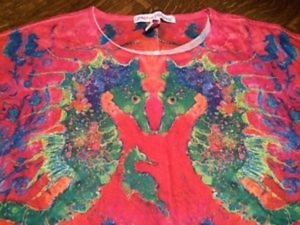 Bealls also likes seahorses, and so do the people who purchase the Lovegrove products they sell bearing my art. In addition to casual and sportswear, you can get Tuvia glasses, handbags, beach towels and wristwatches adorned with my seahorse artwork.
Bealls also likes seahorses, and so do the people who purchase the Lovegrove products they sell bearing my art. In addition to casual and sportswear, you can get Tuvia glasses, handbags, beach towels and wristwatches adorned with my seahorse artwork.
Aside from their popularity among thousands upon thousands of Bealls shoppers, here are some of the reasons I find seahorses so fascinating:
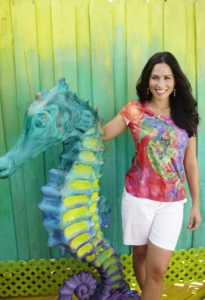 At the top of my list has to be the fact that seahorses pair for life. Now their success in staying together may be attributable to the fact that they respect each other’s space. Female seahorses have a territory that’s about 1.4 square meters in size. The male confines himself to a third of the female’s overall space and never ventures outside of it. So when the female doesn’t want to be bothered, she stays in the other two-thirds with the knowledge and peace of mind she’s not going to be disturbed. Sounds awesome, doesn’t it?
At the top of my list has to be the fact that seahorses pair for life. Now their success in staying together may be attributable to the fact that they respect each other’s space. Female seahorses have a territory that’s about 1.4 square meters in size. The male confines himself to a third of the female’s overall space and never ventures outside of it. So when the female doesn’t want to be bothered, she stays in the other two-thirds with the knowledge and peace of mind she’s not going to be disturbed. Sounds awesome, doesn’t it?
Female seahorses have it over humans in another important way. When she’s in the mood, she swims into his territory and he courts her by dancing. Every morning for days on end, he begins her day by dancing with her. They dance for hours and hours, sometimes as long as eight hours at a stretch. How romantic. Wonder what he sings in her ear. I’ve read that seahorses grunt when they’re 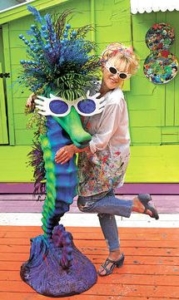 stressed and click when they’re excited, so I’m guessing it’s easy to follow the beat.
stressed and click when they’re excited, so I’m guessing it’s easy to follow the beat.
But wait. It gets even better for female seahorses. That’s because it’s the male seahorse who gets pregnant and gives birth to the babies (which are known as fries). I’m totally serious. The female lays her eggs in the male’s pouch, which he then fertilizes internally. When the time is right, he gives birth to as many as 2,000 fries at a time.
To know me is to know that I adore color, and not only do seahorses come in a wide variety of colors, they also have the ability to change color to match their background and camouflage themselves. They also change color during courtship, and have even been known to turn bright red to match floating debris.
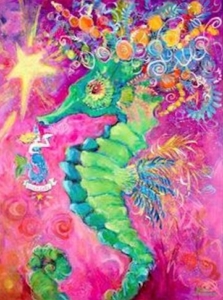 Next on my list has to be that seahorses have neither teeth nor stomachs. They suck up food through their snouts and, because nutrients pass through their digestive track so quickly, they’re eating machines. Adults feed between 30 and 50 times a day (without gaining weight). While they’re quite good sneaking up on prey (they have a 90% kill rate), they don’t swim very fast. So a lot of their success results from their ability to camouflage themselves among coral and seaweed and snatch shrimp and other crustaceans that the current carries by. They’re also able to poke into cracks and crevices with their long snouts.
Next on my list has to be that seahorses have neither teeth nor stomachs. They suck up food through their snouts and, because nutrients pass through their digestive track so quickly, they’re eating machines. Adults feed between 30 and 50 times a day (without gaining weight). While they’re quite good sneaking up on prey (they have a 90% kill rate), they don’t swim very fast. So a lot of their success results from their ability to camouflage themselves among coral and seaweed and snatch shrimp and other crustaceans that the current carries by. They’re also able to poke into cracks and crevices with their long snouts.
I also get a kick out of the fact that seahorses can look forward and backward at the same time. That’s because their eyes work independently of each other. Gives new meaning to having eyes in the back of your head, 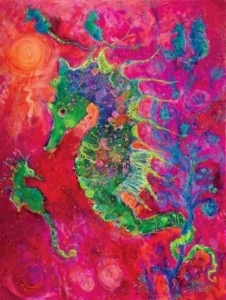 huh?
huh?
Sadly, seahorses are threatened with extinction. Which is another reason I like to pay tribute to them in acrylics on cardboard and canvas.
If you’re interested in buying an original seahorse painting or a signed limited edition print, please call Lovegrove Gallery & Gardens. The number is 239-938-5655. And you can find an assortment of seahorse products at Bealls. Visit them online or in one of their brick-and-mortar locations.
